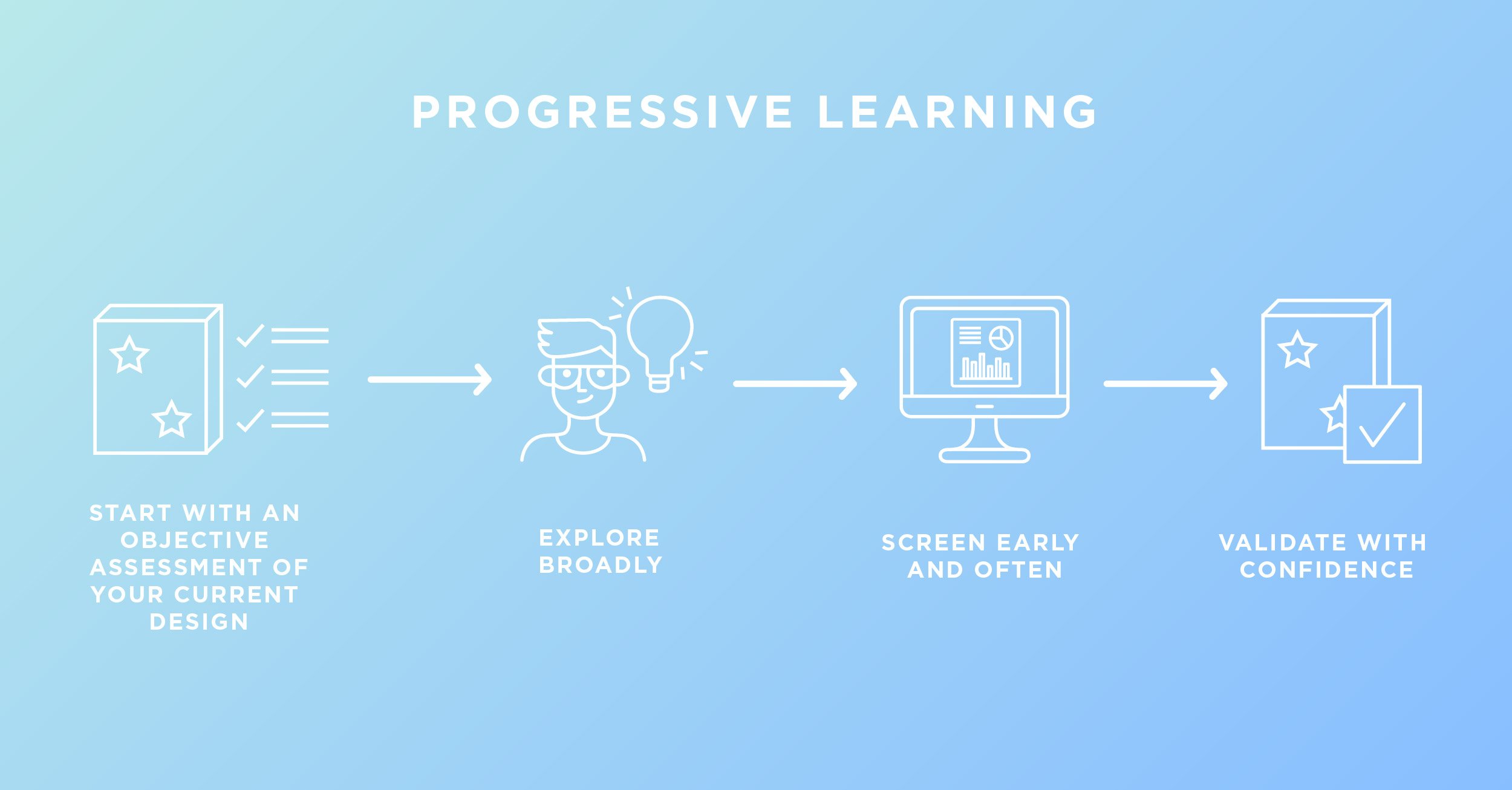We are often asked: What is the number-one way to maximize brand growth through design? There is no one-size-fits-all answer to that question, though there are certainly important things we strongly suggest brands and agencies keep in mind.
But if there is one general rule-of-thumb we share repeatedly and emphatically, it is this:
Test to learn, not to win.
Why? Because in the end, that’s the best way to actually win with design.
Here’s an illustration of how important this approach can be, taken directly from our work with clients. It’s something we call the “3/4 Principle”:
Designalytics’ Versus design screening tool is a fast, cost-effective, and highly-predictive tool that is popular with clients because it helps them quickly learn what works and what doesn’t. The latter is much more likely early on—approximately 75% of the time, a brand’s initial design concepts, when screened with Versus, don’t meet our success threshold for launch to market.*
The good news is that failure at this point is exactly where a brand should be. Because…
When brands refine and re-test their designs after receiving consumer feedback from Versus, around 75% of brands emerge with at least one winning design (and often with several). The swing can be quite dramatic, too—here’s an example of how one brand went from “fail” to fabulous in just two rounds of testing.
To summarize: Three out of four times in a design process, the first design concepts created aren’t winners…. But with the right approach, the second round of designs can completely flip the script and result in huge leaps in effectiveness. The consistency of results like these has fortified our belief in a process we call “progressive learning.”

Through this approach, and with just a few simple adjustments in mindset and tactics, brands can increase the speed of the creative process, lower total project costs, and realize significant growth outcomes.
Here’s an outline of how progressive learning works:
Start with an objective assessment of your current design:
It’s hard to know where to go if you don’t know where you’re starting. By identifying strengths and weaknesses of your design versus your competitors, you can build more effective creative briefs and brand strategies.
Explore broadly:
At the start of a redesign initiative, spread your creative wings… wide. Of course, you’ll want to determine which existing visual assets are “must-keep” because they’re distinctive and meaningful to consumers. Beyond this, though, embrace divergent (and even wild) concepts and ideas in order to test assumptions and break through unnecessary creative barriers. Push the envelope—you’ll know “how far is too far” when you get there.
Screen early and often:
This is the heart of progressive learning, and it rests on an understanding that the early stages of the design process are essentially meant for failure. Screening is a way to learn fast.
Most brands receive less-than-stellar quantitative results from the first round of Versus screening, and it’s actually a good thing. By testing initial design concepts with consumers (ideally including a few, well-differentiated design concepts) at the start of the creative process with a nimble, cost-effective tool, you can use this feedback to refine designs and repeat as needed. Some concepts you thought might succeed could crash-and-burn, and bolder options might surprise you with design elements consumers appreciate.
Once you receive results, share them with your design team or creative agency so that they can propose solutions (e.g., altering the layout or hierarchy of communication, experimenting with different sensory imagery, modifying or amplifying claims, etc.) using consumers’ qualitative feedback. (Here’s an example of the kind of feedback Versus provides.) Not only does this help to winnow the field of concepts, it highlights details that can help take a design from good to great.
Validate with confidence:
Having chosen and polished a likely growth-driving design, the final step is to confirm the design’s performance with 360, which offers a full range of consumer-focused, empirically validated metrics. This comprehensive testing offers a larger sample size and more expansive insights, covering eight design performance areas (including some with competitive context) to help you fine-tune your chosen design route.
Side note: Since many brands are used to this end-of-process test, they often ask for it at the start. We recommend against it at this stage but, if you do skip to 360 testing early and it isn’t a successful design, there’s no reason to panic (remember, you’re in good company on that front!).
Consider using Versus to explore more design concepts in Round 2 to ensure you’ve identified a winning design before moving ahead. (You can run three Versus tests for the cost of a single 360, and receive results in a few business days.) Depending on your specific objectives and organizational requirements, you may then wish to follow-up with more complete testing.
That’s it. The progressive learning approach injects reliable consumer input throughout the design process, emphasizing creative exploration, rapid and reliable design screening, and proven, data-centric validation testing.
Interested in learning more? Reach out to us for a chat about your upcoming design project.
*In the case of redesigns, a test design needs to perform 4+ pts better on committed purchase preference than the current design for Designalytics to say with confidence that we expect to see a sales increase.




